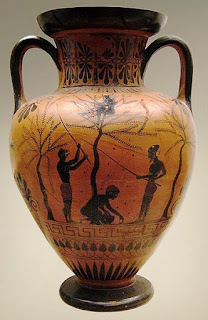Azeite na cultura mediterrânea, mais do que um alimento.
Introduction.
Olive oil is deeply linked to Mediterranean history and culture, or rather, to the cultures that have inhabited this vast area over the centuries. Today it is generally associated with the different forms of cuisines that have developed over time and that today are united under the name of ” Mediterranean diet “In reality, its presence is much more articulated and the connection with the table is just the most visible of its intertwining with human life and with the various aspects that characterize it.
In fact, their presence took root over time in the various aspects of history and involved religious and civil rites, daily rituals and holidays. There are, therefore, a series of aspects of different matrices that characterize it: social, cultural, historical, through this study I would like to reflect briefly on some of them to trace a path that delineates the true nature of olive oil, to better understand its importance yesterday is today.
 |
| (Olive Harvesting, Amphora by Separate Neck, 520 BC about, British Museum, London) |
The cultural characteristics.
I want to highlight these characteristics through the use of quotation marks and italics, so that they are real points through which the olive oil culture is built. It is first and foremost a ” symbol over the centuries “, not so much the image of the Mediterranean area as its culture. Component of the famous triad: olive oil, bread and wine, the culmination of a vast set of values, traditions, myths and stories that converge in these three products. “. elements of various types.
Olive oil is also a ” food and cultural model “, an aspect strongly linked, in reality, to the previous one and in particular to the characteristics of the symbol. Values associated with health, wellness and living well, the syncretic relationship with the territory and its environmental and morphological characteristics, the concept of healthiness, but also of valuing the environment (especially in recent years), but also the history of its uses outside the food context, to ancient agricultural crafts and practices.

Our protagonist also has a ” strong connection to religion”, an extremely complex and articulate relationship. It was above all a fundamental food during periods of abstinence and fasting, especially in the first centuries of Christianity. His link over time with many men and women who, adopting a vegetarian diet as a way of renouncing meat, considered a source of sin and an element that distracts from a life linked to faith, saw olive oil, combined with vegetables, as indissoluble. , a valid substitute. Monasticism, in particular, had this product for a long time as a symbol of nutrition, life and work, even when the use of lard was allowed as a base for cooking vegetables and legumes. But also, therefore, ascetics, hermits, saints, precisely in reference to what was said before, had it, however small a part, in their diet.
It is also an important element in the Jewish biblical tradition and in the Christian liturgy . Numerous rites are performed with blessed or consecrated oil: catechumens are anointed, making them participants in the community of believers; they are consecrated: the churches through the anointing of the altar and the columns that symbolize the twelve apostles, but also kings, priests and bishops and, finally, the person’s earthly end is sealed.
Olive oil is also a bridge that unites the three monotheistic religions. To Christians, in reference to what has just been written, it is a symbol of the Holy Spirit; for Jews it is the alliance between God and man and is one of the protagonists of Hannukkah, a Jewish holiday known as the “Feast of Lights” or “Feast of Enlightenment”. It celebrates the victory of the Jewish people over the Greek rulers who tried to alienate the Jews from the Torah and, in particular, from certain precepts such as the Sabbath rest and circumcision. For Muslims it is one of the symbols of Paradise, in addition the olive tree is the cosmic tree par excellence that symbolizes the universal Man, the Prophet. One of the names of God or other sacred words is also said to be written on each of its leaves. It is also considered the tree of life that generates and gives fertility;

Without distinction, in religion it is also a symbol of divine light and prayer, given by the light produced by its combustion.
Our protagonist is also connected ” to hospitality “, as a way of welcoming travelers or foreigners. Bread and oil are a tasty welcome offering from some North African nomadic tribes, but also from hermits and exegetes. Those men and women (especially from the first centuries of Christianity) dedicated to prayer and renouncing cooked food or, in any case, the common diet, as a rejection of society and its influences, preferred raw plant foods: herbs, roots and whatever nature offered them. they used to season the food of the few visitors who could reach them for short periods.
Finally, olive oil is extremely linked to ” folklore“and the set of traditions and practices of popular origin that are present in each territory. There are many examples of this that could be cited, however I would like to refer in this study to the harvest festivals or new olive oil that accompany the rites, music and food various steps that lead to obtaining our protagonist. It is also used to predict the evil eye and, linked to these practices, there are also the beliefs that have arisen around its accidental loss, cause of misfortunes or even in some locality a harbinger of mourning Of course, this is linked to the value of this product, especially for those places where the cultivation of vines was not part of the territory. Linked to this is also the act of donating it, a symbol of harmony and the desire to increase human relationships .
Therefore, olive oil has always been not just a food, but a true set of multiple meanings of different nature: social, cultural, religious and anthropological. Getting to know them means getting to know an important part of our history but, at the same time, knowing how to consciously value the products of each territory with its cultural and culinary peculiarities.
